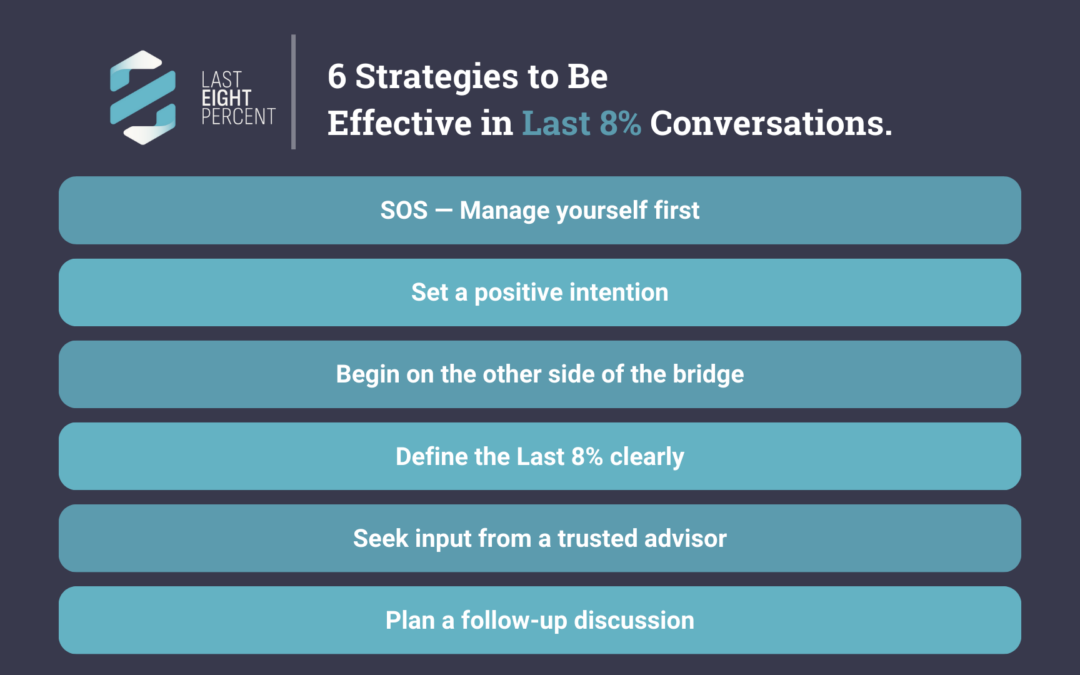One of the biggest challenges faced by everyone across all organizational levels, including CEOs I work with, is mastering the art of handling difficult conversations – what we refer to as “Last 8% Conversations.” We are all pretty good at the 92% of our conversations where everyone is agreeing, but when tension increases and conflict arises, our research shows that 68% of people avoid the Last 8% of a difficult conversation – the part of the conversation that really needs to be said!
Examples of Last 8% Conversations that people commonly shy away from include:
- Providing performance feedback.
- Holding individuals accountable for their deliverables.
- Addressing behavior that has a negative impact on the team.
- Saying no to someone who will be upset about not getting what they want.
- Offering constructive feedback to peers or senior leaders.
What typically stands in the way of these challenging conversations? Fear.
Fear that the conversation may not go well and that we’ll upset or demotivate the other person. Similarly, the other party often fears being criticized, judged, or reprimanded, leading them to become defensive.
Imagine this, though: What if you were guaranteed that the other person would be open to your feedback and might even thank you for it? Would you still avoid the conversation? Probably not.

The key to overcoming this fear so that you have an effective conversation is to manage emotions. IHHP has dedicated 25 years to this pursuit, and we’ve developed six proven strategies to help you navigate difficult emotions in challenging Last 8% Conversations:
1. SOS – Manage Yourself First:
- Stop: Take a step back before initiating the conversation to ensure you’re not triggered. Drink water, stretch, open your palms, or engage in calming activities like prayer, listening to music or exercise.
- Oxygenate: A deep breath counteracts the chemicals (cortisol and adrenaline) that get released when we experience fear. Practice breathing techniques like box breathing or 3-2-4 breathing — breathing in for 3 seconds, holding for 2, and breathing out for 4 seconds.
- Seek Information: What information might you be missing? What assumptions are you making? Ask yourself how you want to show up in this conversation.
2. Set a Positive Intention:
Start the conversation by sharing an intention for you and the other person. This calms the other person’s emotional brain and limits the potential that they will get defensive. Examples include expressing your belief in their potential, your desire for a strong relationship, or your genuine care for their well-being.
3. Begin on the Other Side of the Bridge:
Rather than immediately starting with your point of view, begin by asking questions to understand the other person’s perspective. This approach helps you gather crucial information and allows them to feel heard and valued.
4. Define the Last 8% Clearly:
Before starting, make sure you are clear about what you need the other person to hear, regardless of their reaction. Avoid the temptation to dodge the difficult part of the conversation if their response isn’t as expected.
5. Seek Input from a Trusted Advisor:
Consider running your conversation plan by a trusted coach or colleague. Their insights can help refine your approach and increase your chances of success.
6. Plan a Follow-Up Discussion:
Recognize that some individuals may need time to process difficult conversations. Schedule a follow-up discussion for 24 hours later, allowing them the space to reflect and respond more openly.
By implementing these strategies, you will mitigate the fear and negative emotions that often derail difficult conversations.
Ready to transform your organization’s culture? Contact us today to learn how we can help you develop a high performing culture that fosters courageous and caring conversations. Let’s create a Last 8% Culture together. Get in touch now!

